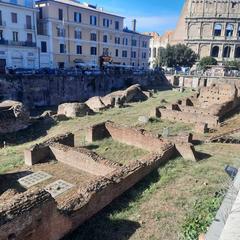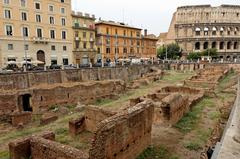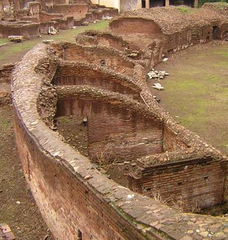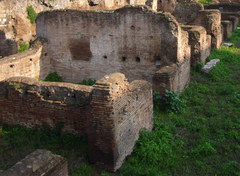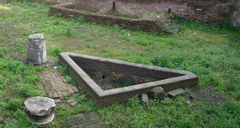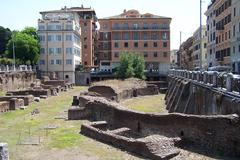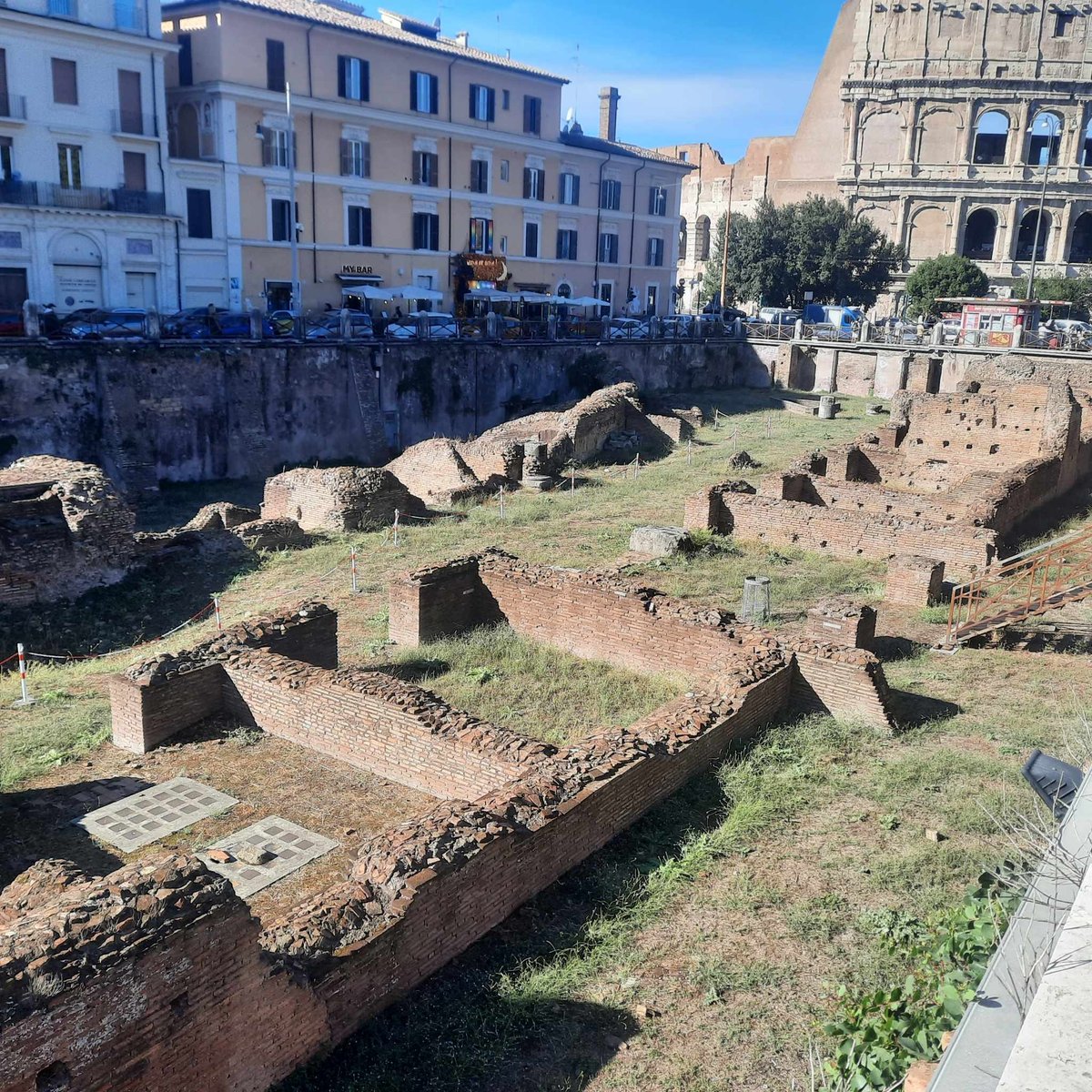
Ludus Magnus: Visiting Hours, Tickets, and Exploring Rome’s Historic Gladiator School
Date: 14/06/2025
Introduction
The Ludus Magnus, standing just east of the Colosseum, is Rome’s largest and most significant gladiatorial training school. Constructed under Emperor Domitian in the late first century AD, it served as the central hub for training gladiators and played a vital role in the spectacle of Roman entertainment. Its remains, partially visible today, offer a unique glimpse into ancient Rome’s social, architectural, and cultural history (Rome Reborn; Wikipedia). This guide provides a comprehensive overview of Ludus Magnus, from its historical origins and architectural features to practical visitor information including hours, tickets, accessibility, and travel tips.
Historical Overview
Origins and Construction
Built between AD 81–96 during the reign of Emperor Domitian, the Ludus Magnus was part of a broader initiative to expand Rome’s entertainment infrastructure (Rome Reborn). Its strategic location adjacent to the Colosseum and direct underground passageway ensured gladiators could move discreetly to the arena, highlighting its functional importance (The Colosseum; UNRV).
Architectural Layout
The complex measured roughly 100 x 130 meters and featured a central elliptical arena (palaestra) surrounded by a two-story portico. The site contained barracks for up to 1,000 gladiators, armories, baths, administrative offices, and a unique network of fountains at each corner of the arena (Roma Sotterranea; Wikipedia). The visible remains today represent about one-third of the original structure, with much still buried beneath modern Rome.
The Gladiator School in Roman Society
More than a training ground, the Ludus Magnus was a microcosm of Roman society. Gladiators, often slaves or prisoners, underwent rigorous training, while the lanista—head of the school—managed both training and the complex’s economic affairs (Ancient History Encyclopedia). Gladiatorial games, staged via the Ludus Magnus and Colosseum connection, became a hallmark of imperial power and public entertainment (Smithsonian Magazine; The Collector).
Archaeological Discoveries
Rediscovered in 1937 and systematically excavated from the 1950s onwards, the Ludus Magnus has yielded significant archaeological finds: the arena, portico fragments, gladiator cells, inscriptions, and even ancient graffiti (Roma Sotterranea). Modern technologies such as ground-penetrating radar and 3D modeling have further illuminated the site’s original structure and its vital link to the Colosseum (Soprintendenza Speciale Roma).
Visiting Ludus Magnus: Hours, Tickets & Accessibility
Location
- Address: Via Labicana / Via di San Giovanni in Laterano, 00184 Rome, Italy
- Nearest Metro: Colosseo (Line B)
Visiting Hours
- Open-air Ruins: The Ludus Magnus is visible from the street at all times, with best visibility during daylight hours.
- Guided Access: Special guided tours may be available on selected dates. Check the official site for updates.
Tickets
- Street-Level Viewing: Free; no ticket required.
- Combined Tickets: Entry to the Ludus Magnus is often included with the Colosseum and Roman Forum combined ticket (approx. €16 for adults), particularly for guided tours that reference the site (Colosseum Rome Tickets).
Accessibility
- The site is viewable from wheelchair-accessible sidewalks.
- No direct access to interior ruins due to preservation; the area is fenced for safety.
- Contact site administration for specific accessibility accommodations if joining a special guided tour.
Visitor Experience & Tips
How to Visit
- Best Viewing: From Via Labicana and Via di San Giovanni in Laterano, offering clear sightlines to the arena, cavea, and gladiators’ cells.
- Interpretive Panels: On-site signage in Italian and English provides historical context and diagrams.
- Visitor Duration: 15–30 minutes is typical; longer if combining with guided tours or nearby attractions.
Best Times to Visit
- Early morning or late afternoon for optimal lighting and fewer crowds.
- June is especially popular, with pleasant weather and extended daylight (Rome Actually).
Practical Tips
- Wear comfortable shoes and bring water, especially in summer.
- The site is exposed—bring sun protection.
- For a more immersive experience, explore digital reconstructions or exhibitions at the Colosseum visitor center (Colosseo.it).
Nearby Attractions
- Colosseum: Iconic amphitheater just across the street.
- Roman Forum & Palatine Hill: Both within walking distance and included in combined tickets.
- Dining & Amenities: Numerous cafes and restaurants line the surrounding streets.
- Accommodation: Options range from luxury hotels to B&Bs, many with views of the Colosseum (Visit Colosseum Rome).
Cultural and Educational Opportunities
Ludus Magnus is a focal point for understanding Roman entertainment, social stratification, and architectural ingenuity. Occasional exhibitions, such as those on gladiatorial spectacles in the Colosseum, highlight the connection between the two sites, including the once-restored underground corridor (Colosseo.it). Some tour providers offer family-oriented or interactive gladiator experiences inspired by Ludus Magnus traditions.
Preservation and Public Access
The site is managed by the Soprintendenza Speciale Archeologia, Belle Arti e Paesaggio di Roma, with ongoing efforts to stabilize ruins and improve visitor information (Roma Sotterranea). Surveillance and fencing protect the site, and visitors are reminded to respect barriers for safety and preservation.
Frequently Asked Questions (FAQ)
Do I need tickets to visit Ludus Magnus?
No, viewing from the street is free and ticketless.
What are Ludus Magnus visiting hours?
The ruins are visible any time, but daylight hours offer the best experience.
Is the site accessible to people with disabilities?
Yes, the site is fully visible from accessible sidewalks.
Can I enter the Ludus Magnus ruins?
No, the ruins are fenced off for preservation.
Are guided tours available?
Yes, some Colosseum-area guided tours reference Ludus Magnus. Private or special tours may offer more detail.
How long should I plan for a visit?
Plan 15–30 minutes, or longer if combining with a tour or nearby attractions.
Visuals
Alt text: Ruins of the Ludus Magnus gladiator school near the Colosseum in Rome.
Summary and Key Takeaways
Visiting Ludus Magnus offers a fascinating, accessible window into Rome’s gladiatorial culture and urban history. Although only a portion is visible today, interpretive resources and its proximity to the Colosseum make it a must-see for travelers interested in ancient Rome (Ancient History Encyclopedia; Wikipedia). Plan your visit with the latest information, combine it with other historical sites, and consider digital or guided resources for a richer experience (Visit Colosseum Rome; Smithsonian Magazine).
Further Reading and Official Sources
- Rome Reborn
- Wikipedia: Ludus Magnus
- The Colosseum: Ludus Magnus
- Roma Sotterranea
- Ancient History Encyclopedia
- Colosseum Rome Tickets
- Turismo Roma
- Smithsonian Magazine
- The Collector
- UNRV: Gladiator Schools (Ludi)
- Colosseo.it: Spectacles Colosseum Arena
- Visit Colosseum Rome
- History Hit: Ludus Magnus
- History Tools: Unveiling the Secrets of the Ludus Magnus
- Italy Tourist Information: Colosseum
- Medium: The Role of Gladiator Schools in Ancient Rome
- Earth Trekkers: How to Visit the Colosseum
- Rome Actually: Visiting Rome in June
Plan your visit now and enrich your journey through Rome’s ancient wonders! Download the Audiala app for guided tours, interactive maps, and the latest updates on historical sites. Explore our other articles for more travel tips and cultural insights.
